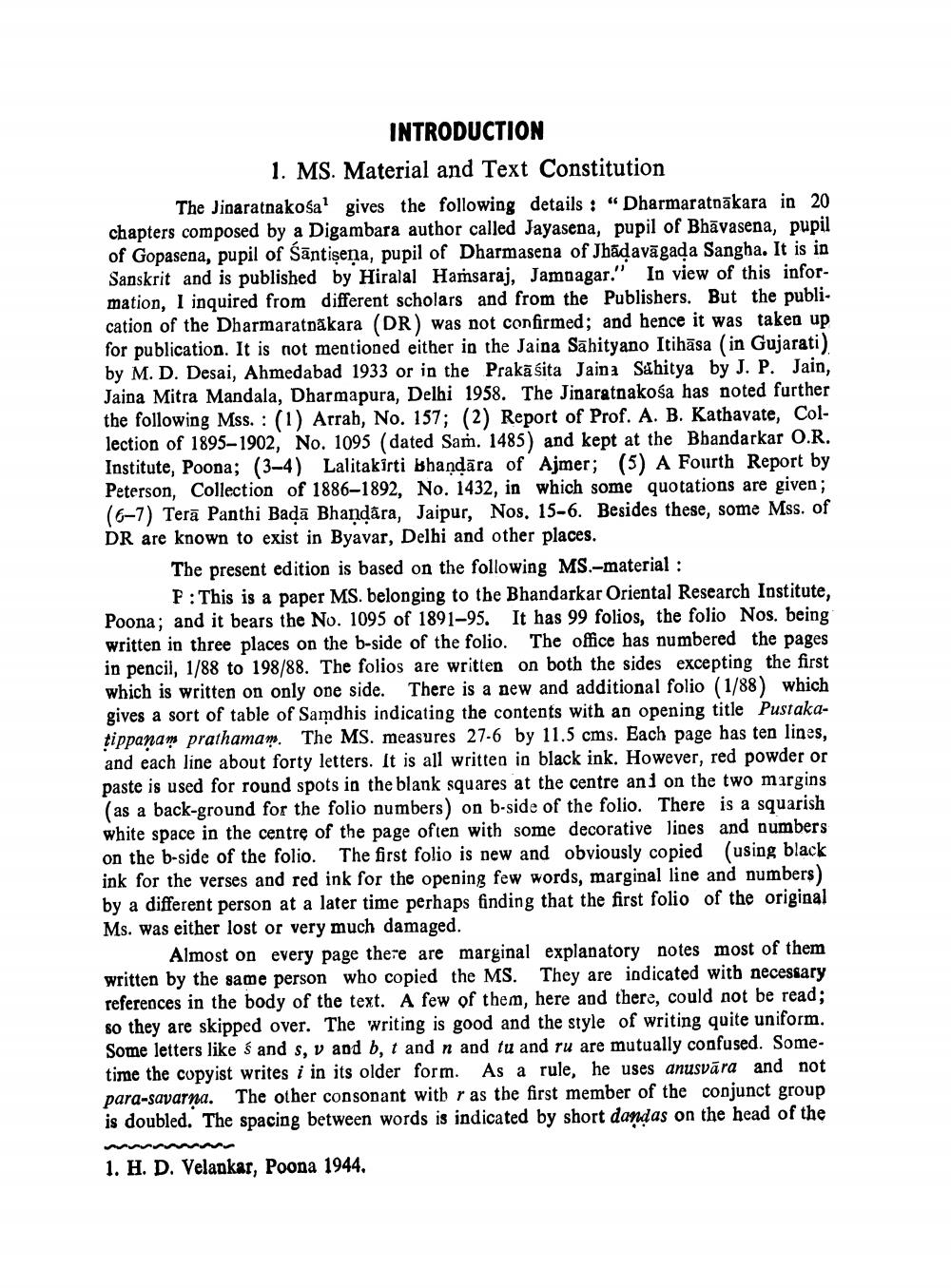________________
INTRODUCTION
1. MS. Material and Text Constitution
The Jinaratnakosa gives the following details: "Dharmaratnākara in 20 chapters composed by a Digambara author called Jayasena, pupil of Bhavasena, pupil of Gopasena, pupil of Säntisena, pupil of Dharmasena of Jhadavagada Sangha. It is in Sanskrit and is published by Hiralal Hamsaraj, Jamnagar." In view of this information, I inquired from different scholars and from the Publishers. But the publi cation of the Dharmaratnakara (DR) was not confirmed; and hence it was taken up for publication. It is not mentioned either in the Jaina Sahityano Itihasa (in Gujarati) by M. D. Desai, Ahmedabad 1933 or in the Prakasita Jaina Sahitya by J. P. Jain, Jaina Mitra Mandala, Dharmapura, Delhi 1958. The Jinaratnakosa has noted further the following Mss. (1) Arrah, No. 157; (2) Report of Prof. A. B. Kathavate, Collection of 1895-1902, No. 1095 (dated Sam. 1485) and kept at the Bhandarkar O.R. Institute, Poona; (3-4) Lalitakirti Bhandara of Ajmer; (5) A Fourth Report by Peterson, Collection of 1886-1892, No. 1432, in which some quotations are given; (6-7) Tera Panthi Bada Bhandara, Jaipur, Nos. 15-6. Besides these, some Mss. of DR are known to exist in Byavar, Delhi and other places.
The present edition is based on the following MS-material:
F: This is a paper MS. belonging to the Bhandarkar Oriental Research Institute, Poona; and it bears the No. 1095 of 1891-95. It has 99 folios, the folio Nos. being written in three places on the b-side of the folio. The office has numbered the pages in pencil, 1/88 to 198/88. The folios are written on both the sides excepting the first which is written on only one side. There is a new and additional folio (1/88) which gives a sort of table of Samdhis indicating the contents with an opening title Pustakatippana prathama. The MS. measures 27-6 by 11.5 cms. Each page has ten lines, and each line about forty letters. It is all written in black ink. However, red powder or paste is used for round spots in the blank squares at the centre and on the two margins (as a back-ground for the folio numbers) on b-side of the folio. There is a squarish. white space in the centre of the page often with some decorative lines and numbers on the b-side of the folio. The first folio is new and obviously copied (using black ink for the verses and red ink for the opening few words, marginal line and numbers) by a different person at a later time perhaps finding that the first folio of the original Ms. was either lost or very much damaged.
Almost on every page there are marginal explanatory notes most of them written by the same person who copied the MS. They are indicated with necessary references in the body of the text. A few of them, here and there, could not be read; so they are skipped over. The writing is good and the style of writing quite uniform. Some letters like s and s, v and b, t and n and tu and ru are mutually confused. Sometime the copyist writes i in its older form. As a rule, he uses anusvāra and not para-savarna. The other consonant with r as the first member of the conjunct group is doubled. The spacing between words is indicated by short dandas on the head of the
1. H. D. Velankar, Poona 1944.




